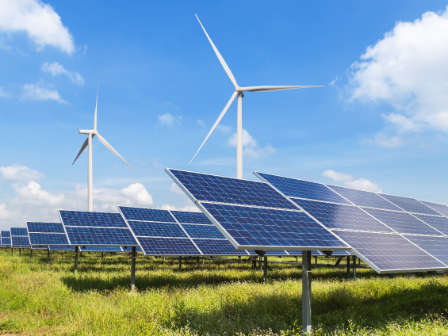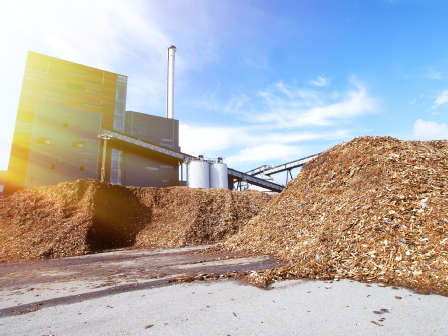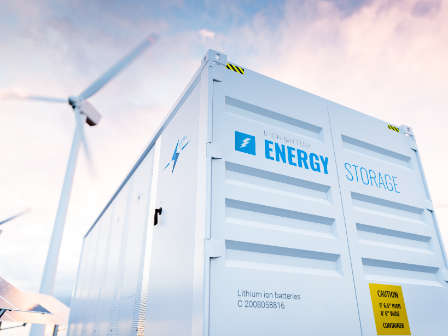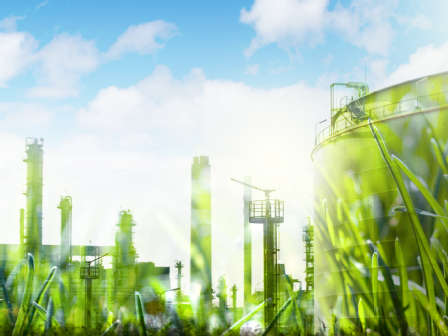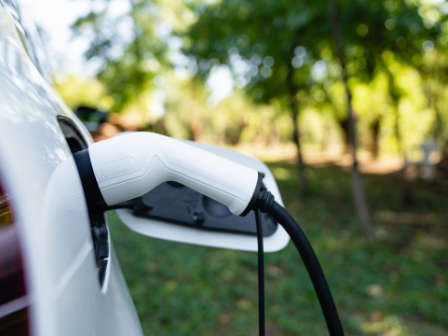
A decarbonized energy system is the foundation for a competitive business location
A holistic view of the entire energy system is indispensable for a coordinated and efficient transformation
CEOs FOR FUTURE’s Vision for a Decarbonized Energy Future
The system vision presented below is based exclusively on the abovementioned stakeholders' assessments and visions. APG merely provides the modeling system within the context of the zusammEn2040 project - APG's position can therefore not be derived from the statements.
The aim of the non-profit organization CEOs FOR FUTURE is to promote and accelerate the sustainable transformation of the economy and society. We want to take responsibility for current and future generations and actively shape our economy's future in harmony with our planet's available resources. In our Climate Business Circle, we work on cross-sector and cross-industry solutions and, as the voice of the economy, want to call attention to the economic opportunities of the transformation. We want to give impulses to create the necessary framework conditions and see ourselves as a platform for constructive forces. We are looking to engage with stakeholders from politics, business, and civil society, and we are happy to discuss our energy goals.
The energy transformation is an opportunity for business enterprises and for Austria and Europe as a business location. With the support of the zusammEn2040 project team, the Climate Business Circle has developed an ambitious energy system vision that aims to map out a cost-efficient transformation path to a climate-neutral energy system. The energy target vision of the CEOs FOR FUTURE’s Climate Business Circle is intended to show that the energy transition can only be achieved through holistically conceived and coordinated solutions and that this transformation is the prerequisite for the positive development of Austria as a business location.
Against this background, the following nine key propositions were developed, and APG’s energy system model was used to analyze and quantify the individual items as part of the public stakeholder process in the context of zusammEN2024.
Results at a glance
The energy transition is a key location factor, a basic prerequisite for the activities of companies in all sectors and for the achievement of climate and energy targets. The transition to a decarbonized energy supply will result in a reduced dependence on imports of fossil fuels and thus to positive value creation effects in Austria. The decarbonization and transformation to a climate-neutral system is an opportunity for Austria and Europe!
The integration of renewables, grid expansion, flexibility and storage options as well as comprehensive sector coupling must already be considered at present with regard to the whole energy system if the energy transition is to succeed. Digitalization is essential in this context. The coordinated interaction of all sectors and energy sources facilitates an efficient transformation of the energy system. Multiple synergy effects can thus be harnessed in a clear target vision.
The energy transition requires a massive acceleration in the expansion rate of renewable energy sources in all areas as well as the associated transportation and distribution infrastructure.
Decarbonization of the demand sectors and the expansion of renewables will lead to a strong electrification of the energy system. Electrification is the central pillar and basic prerequisite for decarbonization.
Electric applications in all sectors are much more efficient than other technology options such as combustion technologies. By switching to electric options, massive efficiency gains can be achieved and energy demand can be reduced while maintaining the level of prosperity. Coordinated sector coupling and energy-saving measures can further reduce energy demand.
The production of renewable gases and hydrogen is energy-intensive and costly. They are therefore used in areas of industry and the transport sector that are difficult to electrify and where there are no other emission-neutral alternatives (yet). In addition, green gas power plants also play an essential role in security of supply - especially for peak load coverage.
In addition to electricity, district heating is also becoming increasingly important in a decarbonized energy system. Natural gas and oil in the heat supply are being replaced by a broad generation portfolio of renewable energy sources.
A decarbonized, renewable energy system is less dependent on net imports. The proportion of energy imports can be massively reduced by switching to domestically generated renewable energy.
Austria's central location in the heart of Europe means that it plays an important role in the European energy system. The exchange of energy with and transit through Austria is highly relevant in green Austria for both electricity and gases.
Assumptions used for the CEOs FOR FUTURE system vision
The basic premises for the scenario are the achievement of the political climate and energy targets at a national and international level, as well as securing the energy supply for the industry sector. Based on the assumptions made in the scenario, the aim is to show that the energy transition is achievable and will bring significant efficiency gains.
The results of the model-based study in detail
Based on the assumptions made by CEOs FOR FUTURE and the model parameters entered, the energy system model calculates an “optimal” and cost-efficient energy system on the path to 2050. The most important findings are presented below:
The energy transition is an opportunity for Austria and Europe
The switch to a domestically produced and decarbonized energy supply will make Austria less dependent on imports of fossil fuels. As stated in the EU Competitiveness Compass, Russia's manipulation of our dependence on Russian gas was one of the main causes of the recent price spikes. By increasing the level of domestic production in the scenario from around 35% in 2020 to 69% in 2040 and 76% in 2050, the stability of prices can be strengthened.
Achieving the energy transition is a key prerequisite for reaching the European climate and energy targets. Failure to achieve these targets does not only have consequences for nature and the environment but also comes with budgetary implications. If the 2030 climate targets are not met, Austria faces costs of up to €5.8 billion for the purchase of emission allowances (Scenario With Existing Measures, WEM – NEKP).1
[1] Climate protection in Austria; Follow-up-review. 2024. Austrian Court of Audit. Available at: Report of the Court of Audit: Climate protection in Austria; Follow-up(-review
Development of the domestic production rate vs. the net import rate in % (measured against gross domestic consumption)
.png)
The clean energy system must be viewed as an integrated system to ensure an efficient and coordinated transformation.
The integration of renewables, grid expansion, flexibility and storage options, as well as comprehensive sector coupling must already be considered at present with regard to the whole energy system if the energy transition is to succeed. Digitalization is essential in this context. The coordinated interaction of all sectors and energy sources facilitates an efficient transformation of the energy system. Multiple synergy effects can thus be harnessed in a clear target vision.
The energy flow diagram shows that electricity is becoming the most important energy source. Generation from renewable electricity sources dominates primary generation. Bioenergy in the form of biogas and solid biomass also plays a significant role in generation. Sector coupling and energy storage will play a key role in the future of the energy supply (the energy flow diagram shows schematically what proportion of primary generation is converted into other energy sources or temporarily stored). Imports, which will be greatly reduced compared to today, especially green gases and liquid fuel for the industry sector and aviation, represent fully decarbonized energy sources in the target vision (green imports or decarbonized through carbon management).
Net energy flow picture after decarbonisation in AT in TWh
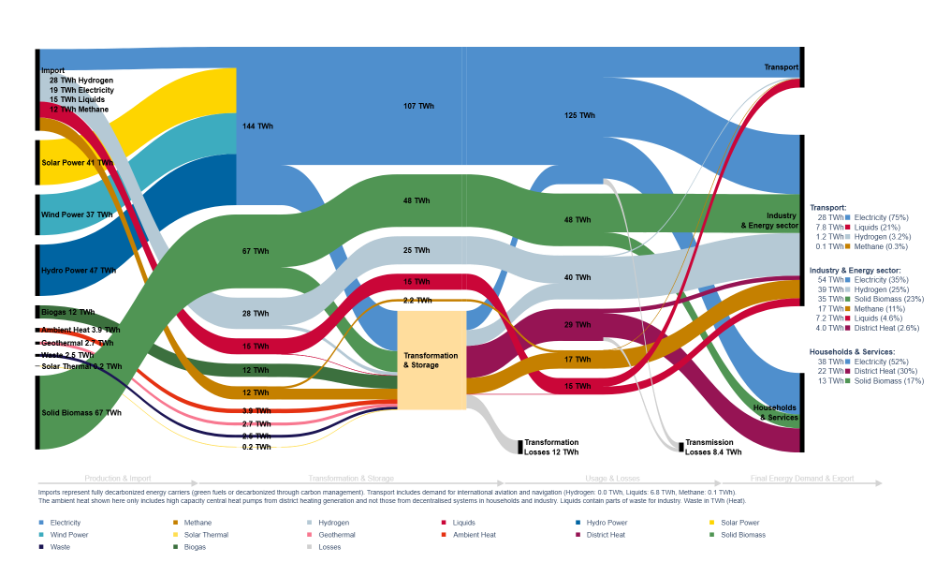
Electrification is the central pillar of decarbonization and leads to a massive increase in efficiency
Electrification is a central pillar of decarbonization. A decarbonized energy system with strong electrification is much more efficient - without any loss of comfort but with economic growth. Together with renewable electricity generation, the consumption of electricity will increase massively by 2040 and 2050.
Energy demand, incl. total final consumption, conversion, and losses in AT in TWh

The significant efficiency gains in the future energy system will primarily result from the electrification of the demand sectors. The diagram shows that the electricity demand in the total final consumption2 will almost double by 2050. At the same time, there will be a sharp reduction in the total final consumption, which will fall by 23% by 2050. The strongest increase in electricity demand by 2050 will be in the mobility sector (+25 TWh), followed by the industry (+27 TWh) and the household and service sectors (+7 TWh). The chart on the final consumption by sectors shows that the greatest efficiency gains will result from the electrification of the mobility sector.
[2] Total final consumption incl. energy and non-energy requirements of all demand sectors, incl. upstream conversion processes in industry (balance limits as for NEFI - New Energy for Industry) but excluding. electricity consumption for electrolysis and power-to-Heat)
Total final consumption (energy and non-energy) in AT in TWh
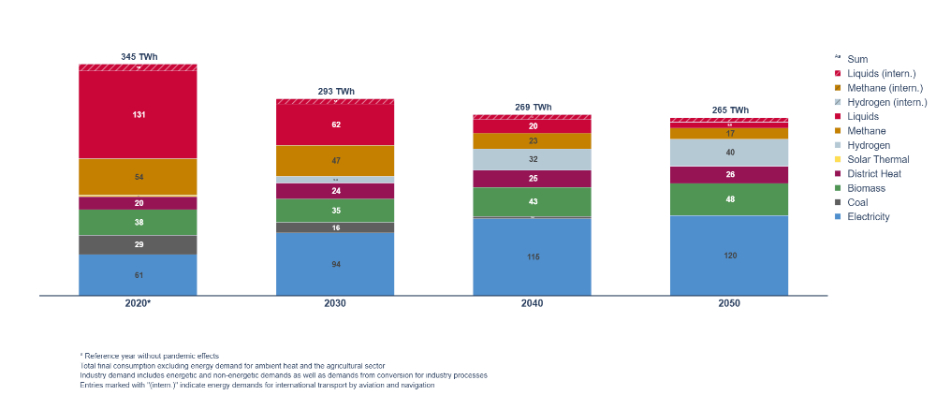.png)
Total final consumption (energy and non-energy) by sector in AT in TWh
.png)
The following diagram is a sample calculation for a model household and illustrates the significant efficiency gains that can be achieved by switching to electric mobility and heat pumps. A 3-person household in a one-family house can thus save around 19 MWh of final energy per year.
Example calculation for a household: An electrified household is much more efficient without any loss of comfort
The expansion of renewable energies must go hand in hand with the expansion of the necessary grid and storage infrastructure
The energy transition requires a massive acceleration in the rate of expansion of renewable energy sources and the associated transportation infrastructure in all sectors. Renewable electricity generation and storage capacities must increase by a factor of 4 from 22 GW in 2020 to 82 GW in 20503. Photovoltaic capacities must increase eightfold from 6 GW in 2024 to 41 GW in 2050, while wind power capacities must increase fourfold from 4 GW in 2024 to 15 GW in 2050. Hydropower plants and storage facilities, as well as controllable power plants and batteries, must also be expanded to make electricity production renewable. A coordinated expansion of the entire infrastructure, including grids and storage facilities, is needed so that the cheaply generated electricity from renewable sources can be integrated.
[3] Water storage, including pumped storage and reservoirs in APG control area
Power generation capacities in AT in GW
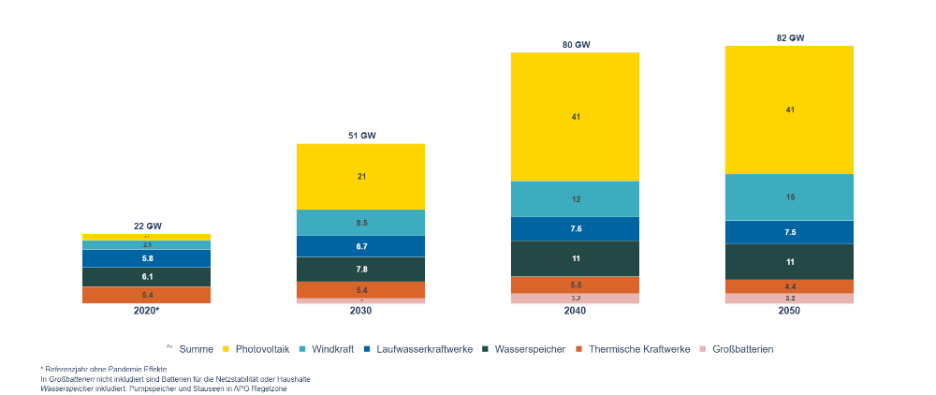.png)
Austria's role in the European Interconnected System will become even more important with increasing decarbonization
Austria's role in the European electricity system is becoming increasingly important due to decarbonization and electrification. The exchange of energy with and through Austria and with our neighboring countries via interconnector capacities is an important flexibility option.
Electricity balance AT: Comparison of electricity production and consumption in AT in TWh

Coordinated planning with electricity in the leading role is essential for security of supply
The expansion of weather-dependent, renewable generation plants results in an increased volatility in electricity generation. At the same time, the demand for electricity, and thus also the peak loads, are increasing massively due to the electrification of the demand sectors. Additional flexibility and storage capacities are required to integrate the bigger share of renewable energy into the system. As a result of these developments, sector coupling (e.g., power-to-heat, power-to-gas systems) is becoming increasingly important. Only holistic planning tools and a cross-sectoral approach can ensure that sector coupling provides additional flexibility for the electricity system. The diagram illustrates the relevance of sector coupling technologies in this context. The demand for heat (power-to-heat) and electricity for electrolysis (power-to-gas) follows the renewable electricity generation from wind and PV. Storage systems also support the integration of renewables through load shifting - both in the short (intraday, weekly) and long term (seasonal).
Sector-coupled interaction of wind, PV, power-to-gas, power-to-heat, and electricity storage after decarbonization in AT in MWh

The decarbonization of district heat is based on a broad generation portfolio
Heat generation will be completely decarbonized by 2040. Fossil fuels will primarily be replaced by heat pumps, geothermal energy, and biomass. District heating is essential for the provision of heat in a decarbonized energy system. In 2050, 26 TWh of the final energy demand will be covered by district heating compared to 20 TWh in 2020. To achieve this, the district heating supply must be decarbonized through power-to-heat, biomass, and geothermal energy, and the associated district heating infrastructure must be expanded.
District heating generation after decarbonization in AT in MWh (daily totals)

Green gases play a key role in a decarbonized energy system
The diagram shows the targeted use of hydrogen, particularly in sectors that are difficult to decarbonize – the industry and transport sectors. To meet the rapidly increasing demand for green gases in the future, it is essential to develop the associated production and transportation infrastructure. In Austria, there will be a ramp-up of electrolysis capacities from 1 GWel in 2030 to 3 GWel in 2040.
Green gases also play an important role in ensuring the security of supply in the electricity and heating sectors. Thermal power plants based on green gases can be used to cover demand at peak load times and also contribute flexibility to the electricity system.
Hydrogen balance in AT in TWh
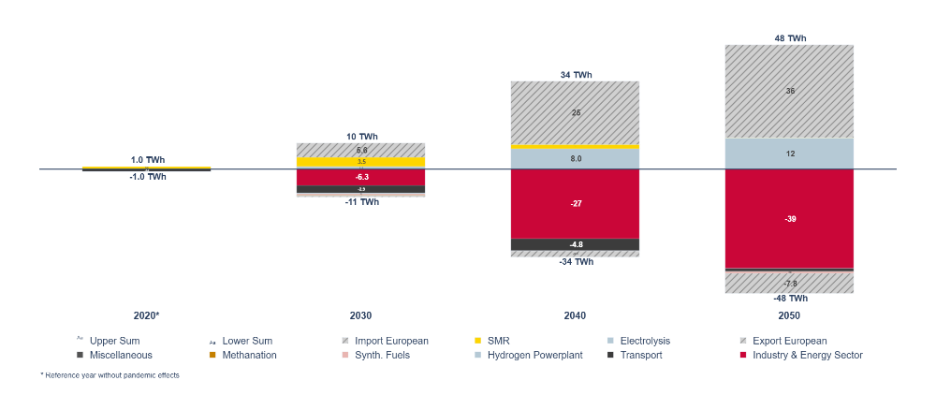.png)


